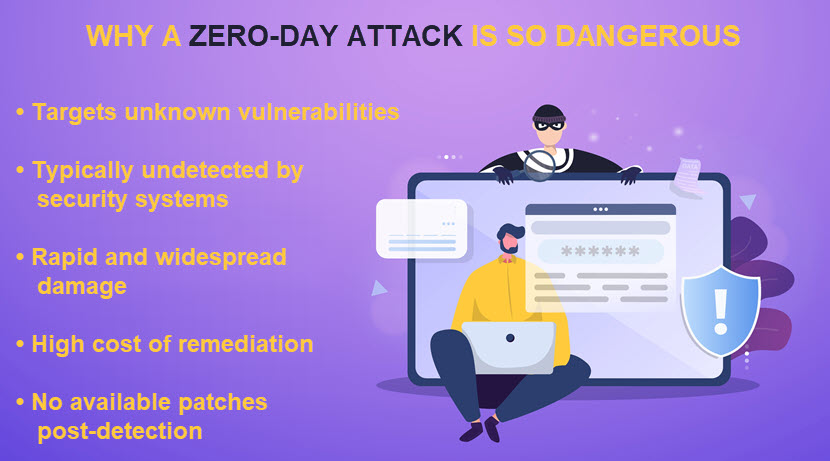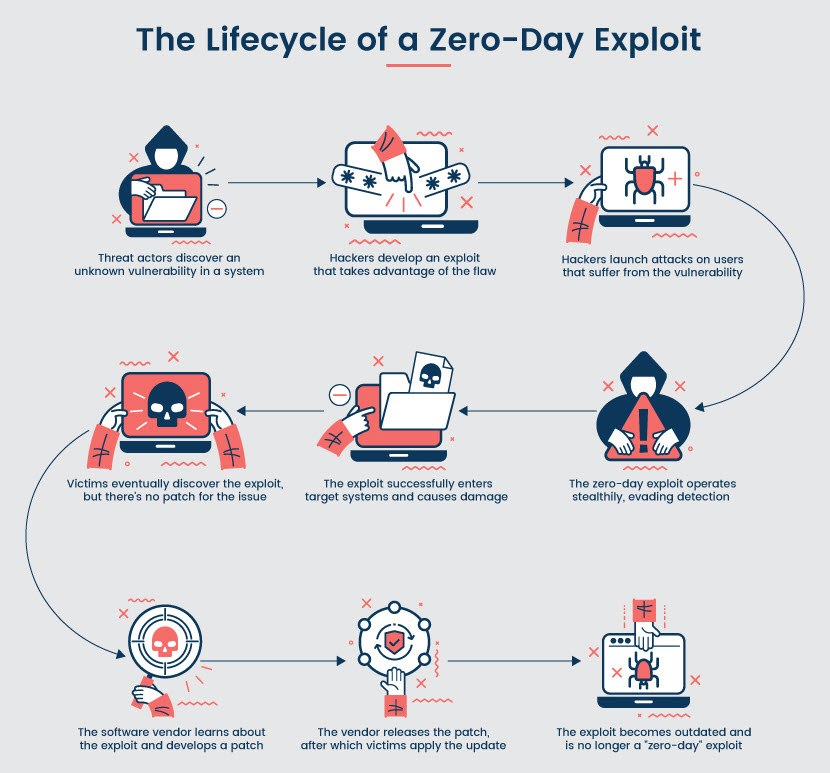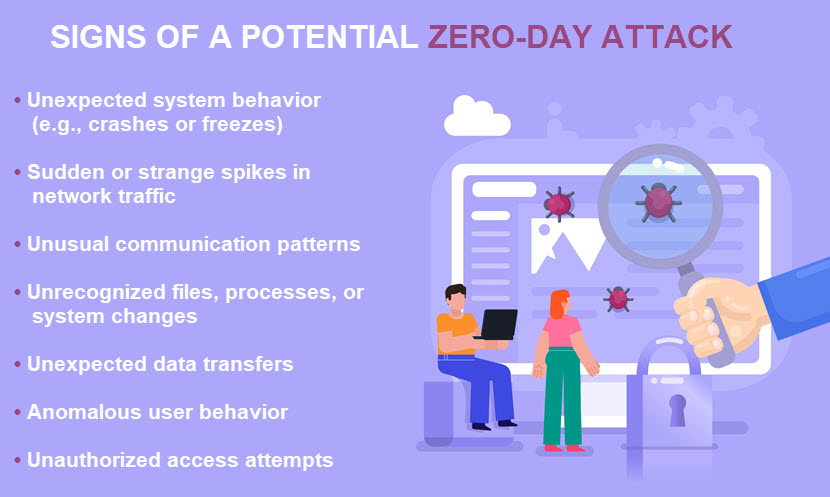Zero-day vulnerabilities in IT systems are security flaws that have not yet been discovered. Threat actors may find a zero-day vulnerability before others, and then use it to manipulate a system. (e.g. gain unauthorized entry, execute code, steal information, take remote control etc.). This article provides a comprehensive guide to zero day exploits and how companies can deal with the threat of unknown security flaws. What is a zero-day attack?
An exploit that hackers use is one where they exploit a flaw in software, hardware or firmware. The team responsible for fixing this vulnerability is unaware of the exploit. The term “zero-day” indicates that there’s no time between the first attack and the moment the vendor learns about the vulnerability. A zero-day exploit, vulnerability, and attack are not interchangeable terms. Here’s what each of these terms represents:Zero-day vulnerabilities are security flaws discovered by somebody before the software vendor learns about the issue.
A zero-day exploit is a specific technique or tactic of using a zero-day vulnerability to compromise an IT system.
Zero-day attacksare cyberattacks that rely on a zero-day exploit to breach or damage the target system.A zero-day exploit is typically a means to an end for a hacker. The exploit allows a threat actor access to a system or manipulate it, and then the criminal can proceed with their true goal (e.g. steal data, install ransomware, setup an APT etc.)
- Almost 75% of zero-day exploits leverage memory corruption issues that enable threat actors to manipulate:Buffer overflows.Out-of-bounds read/writes.
- The second most common cause (around 14%) are logic and design mistakes that allow sandbox escapes and remote privilege escalations.In an ideal scenario, the person who discovers a zero-day vulnerability is an ethical hacker who notifies the vendor about the issue. Users must update their systems as soon as the patch is available. As a result, attackers compromised thousands of devices and spied on calls and messages. In 2020, hackers exploited a zero-day vulnerability in ZOOM to remotely access any PC running an older Windows version. The exploits targeted remote code-execution (RCE) vulnerabilities and allowed attackers to infect devices and run scripts. The flaw was used to change security settings and install malware. The malware allowed hackers to remotely access iOS devices, allowing them to steal data or listen to phone calls. Hackers scraped public data from an archive (names and email addresses, telephone numbers, job titles etc.). This zero-day exploit allowed hackers to gain domain admin privileges. This zero-day exploit enabled hackers to gain domain admin privileges.
How Does a Zero-Day Exploit Work?
All zero-day exploits start with the discovery of an exploitable flaw. There are two common ways threat actors discover vulnerabilities:
- Interacting and experimenting with an application.
- Buying info on vulnerabilities on the Dark Web.
Once hackers learn about a flaw, they figure out how to exploit the vulnerability. This step is usually accompanied by the creation of malicious software. The exploit owner decides who to attack. There are two general types of strategies, depending on what exploit hackers discovered:
Targeted attacks:
Hackers discover an exploit and want to use it against a specific organization or individual.Non-targeted attacks:

Hackers find an exploit and plan to infect as many systems as possible. Criminals use automated scanners and bots to find victims who have the flaw.
Next they infect the target device. Hackers will use standard methods to infect devices if the zero-day vulnerability does not allow them to gain access.
Malicious websites that perform drive-by downloads.
- Malvertising.
- Direct network attacks.
- Once hackers are inside the system, the zero-day vulnerability enables them to perform a malicious activity, such as:
- Remote Code Execution (RCE).
- Injection of malicious code.
- Privilege escalation.
- Bypassing of authentication mechanisms.
Data exfiltration (login credentials, financial data, intellectual property, etc. ).
Interception or eavesdropping of network traffic.
- Manipulation of network infrastructure.
- Setup of persistent access and backdoors.
Remote control takeover.
The attacker continues to exploit the vulnerability until targets detect and report malicious activity, after which the vendor must patch the flaw and distribute an update. This time frame varies greatly depending on the complexity of the issue, but on average takes around 97 days. Who Are Zero-Day Exploit Attackers?Attributing zero-day exploits is challenging since attackers use different techniques to hide their identities, such as:
Routing attacks through multiple compromised systems.
- Using various encryption techniques.
- Utilizing anonymization services.
- Over 40% of zero-day exploits from 2020, 2021, and 2022 remain unattributed and unclaimed. Here are some common categories of zero-day exploit attackers:
- Cybercriminal individuals and groups motivated by financial gain (either by breaching targets directly or selling exploits to other hackers).
Nation-states and private intelligence agencies that develop zero-day exploits for espionage, surveillance, or offensive cyber operations.
- Hacktivism groups that hack computer systems to promote social or political causes.
- Cybersecurity researchers who test exploits without proper authorization or for personal gain.
- Ready-made exploits regularly command prices of over $1 million on the Dark Web. Another figure worth knowing is that
- the cost of successful zero-day attacks now averages $8.94 million
- if you factor in the costs of remediation, IT staff resources, the hit on end-user productivity, and data theft.
- Who Are the Targets of Zero-Day Exploit Attacks?
- Zero-day exploits leverage vulnerabilities in a variety of systems, including:
- Operating systems.
- Web browsers.
- Office apps.
Network protocols.Open-source and commercial tools.

Anti-virus and malware tools.
Hardware and firmware.
- Hardware components.
- Internet of Things (IoT) devices.
- Anyone using these technologies can be a target of zero-day exploits, which means anyone connected to the Internet is a potential victim. Attackers either go after a specific target or look to infect as many victims as possible:
Targeted zero-day attacks go after potentially valuable targets (SMBs, large organizations, government agencies, high-profile individuals, healthcare organizations, technology companies, etc. ).
- Non-targeted attacks go after anyone with a device that contains a vulnerability. These campaigns enable attackers to gather personal data (such as passwords, credit card info, or healthcare data) or turn devices into bots for DDoS attacks.
- Worried about someone using botnets to slow down or crash your network? Our DDoS server protection counters this threat with auto traffic filtering tools and near-instant infrastructure mitigation.
- How Common Are Zero Day Exploits?
- Estimating how many zero-day exploits are currently active is impossible since, by nature, these techniques rely on unknown vulnerabilities. The consensus is that zero-day exploits are relatively rare compared to exploits of known vulnerabilities.
In 2022, threat actors discovered and leveraged a total of 55 zero-day vulnerabilities (53 of which enabled hackers to elevate privileges or execute code remotely). The number of zero-day attacks has decreased from the previous year, when there were at least 66. However, the total number is increasing. Zero-day attacks do not have known signatures (patterns that enable tools to recognize threats, such as specific byte or instruction sequences), so the best way to identify an exploit is to rely on behavior analytics.
Here’s how companies increase their chances of detecting zero-day exploits:
Boost network monitoring with tools that analyze network traffic and behavior for anomalies and suspicious activity. Use behavior-based tools to monitor user behavior, system processes and app activities. These tools establish a baseline of normal behavior and flag all activities that deviate from the norm.
- Improve endpoint security with tools that use behavior-based analysis, ML, and AI to detect and stop malicious activities on endpoints.
- Deploy an attack surface management (ASM) tool that continuously monitors your attack surface in search of unauthorized assets (e.g., shadow IT devices or rogue cloud instances).
- Employee training also improves your ability to detect zero-day exploits. Raise your workforce’s awareness of zero-day threats and educate them on social engineering techniques and safe computing practices.
- Our article on security awareness training provides valuable tips on making your training sessions as engaging and impactful as possible.
- What Are the Best Defenses Against Zero-Day Exploit Attacks?
- Since every zero-day exploit targets an unknown vulnerability, companies cannot guard against specific exploits. This strategy minimizes the window of opportunity for attackers to exploit newly discovered vulnerabilities. This strategy minimizes the window of opportunity for attackers to exploit recently discovered vulnerabilities.
- Set programs to auto-update (where possible).
- Deploy tools with behavior-based analytics to detect anomalies and unusual activities.
- Set your anti-virus tool to flag out-of-date software.
Ensure employees never download and install software from untrusted sources.
- Educate employees about security best practices to reduce the likelihood of social engineering breaches.
- Set up a security scheme (e.g., Wi-Fi Protected Access 2) to boost protection against wireless-based attacks.
Segment your network to limit an attacker’s ability to move laterally and reach mission-critical parts of the network.
Use an endpoint security tool that monitors for and responds automatically to anomalous code execution.
Enforce zero trust security to reduce the potential impact of successful zero-day exploits and prevent attackers from gaining excessive control or access.
Tighten network access controls to prevent rogue machines from gaining remote access to mission-critical systems.Perform input validation and sanitization to prevent hackers from experimenting with input fields.Use IPsec (the IP security protocol) to apply in-transit encryption and authentication to network traffic.

Perform regular vulnerability assessments to discover exploitable flaws.
Consider outsourcing penetration testing services to see how your systems stand up to ethical hackers.
Develop an incident response plan to quickly and effectively respond to zero-day exploits and attacks.
- Remember to stay proactive with your defensive strategy
- . Find weak points and blind spots before threat actors, ensure admins have full transparency over network traffic, and never ignore patches to OSes and apps.
- Take Zero Chances with Zero-Day Exploits
- Despite their relative rarity compared to malware and viruses, zero-day exploits remain a considerable concern for organizations. Zero-day exploits are a serious concern for organizations, despite their rarity compared to malware and viruses.
